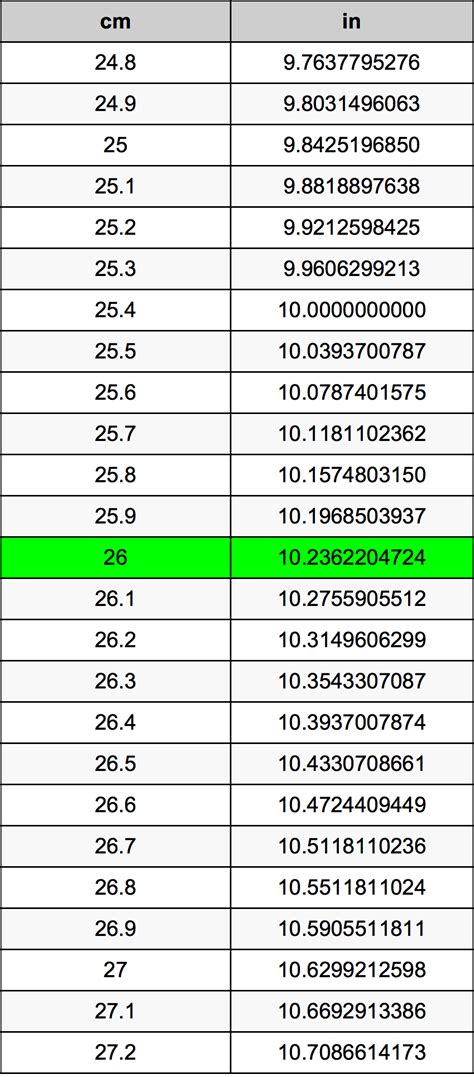26 Inches Is How Many Cm
Kalali
Apr 03, 2025 · 4 min read

Table of Contents
26 Inches is How Many Centimeters? A Comprehensive Guide to Unit Conversion
Knowing how to convert units is a fundamental skill with applications across various fields, from everyday tasks to complex scientific calculations. This comprehensive guide will delve into the conversion of inches to centimeters, focusing specifically on the question: 26 inches is how many centimeters? We'll explore the conversion process, its practical applications, and even touch upon the historical context of these units of measurement.
Understanding Inches and Centimeters
Before diving into the conversion, let's establish a clear understanding of the units involved:
-
Inches (in): An inch is a unit of length in the imperial and US customary systems of measurement. It's historically defined as 1/12 of a foot.
-
Centimeters (cm): A centimeter is a unit of length in the metric system, specifically one-hundredth of a meter. The metric system is widely used globally and is preferred in scientific contexts due to its decimal-based nature.
The Conversion Factor: The Key to Accurate Calculations
The key to converting inches to centimeters lies in the conversion factor. This factor represents the ratio between the two units. One inch is equal to approximately 2.54 centimeters. This is a crucial piece of information for all inch-to-centimeter conversions.
Calculating 26 Inches to Centimeters
Now, let's address the central question: How many centimeters are there in 26 inches?
Using the conversion factor (1 inch = 2.54 cm), we can perform a simple multiplication:
26 inches * 2.54 cm/inch = 66.04 cm
Therefore, 26 inches is equal to 66.04 centimeters.
Practical Applications: Where This Conversion is Useful
The ability to convert inches to centimeters is incredibly useful in numerous situations, including:
-
International Trade and Commerce: Many products are manufactured and sold internationally. Accurate conversions are essential to ensure proper sizing and specifications are understood by all parties involved. Imagine exporting clothing – precise measurements are vital for avoiding returns or dissatisfied customers.
-
Engineering and Manufacturing: Engineers and manufacturers frequently work with blueprints and designs using different unit systems. Accurate conversions are crucial for creating precisely-sized components and avoiding costly errors. Consider designing a car part – a slight miscalculation could render the entire assembly unusable.
-
Construction and Home Improvement: Whether you're working on a DIY project or a large-scale construction endeavor, precise measurements are critical. Converting between inches and centimeters allows seamless integration of materials and designs from various sources. This is especially important when working with internationally sourced materials.
-
Healthcare: In healthcare, accurate measurements are essential for diagnosing and treating patients. For instance, measuring vital signs, body dimensions, or medication dosages often requires converting between units.
-
Scientific Research: In many scientific fields, data may be collected using different unit systems. Conversion is crucial for consistency and comparison across experiments and studies. Imagine researching plant growth; converting inches to centimeters allows you to compare your data to research conducted in other parts of the world.
Beyond 26 Inches: Mastering the Conversion Process
While we've focused on converting 26 inches, understanding the fundamental principle allows you to convert any number of inches to centimeters. Simply multiply the number of inches by 2.54 cm/inch.
Exploring the History: A Glimpse into Measurement Systems
The existence of both imperial and metric systems highlights the evolution of measurement through history. The imperial system, rooted in various historical standards, lacks the inherent consistency of the metric system, developed in the late 18th century based on decimal increments. Understanding this historical context offers insights into the complexities of unit conversions and the ongoing efforts for global standardization.
Advanced Conversion Scenarios: Handling Fractions and Decimal Values
While the example of 26 inches is straightforward, many practical applications involve fractional or decimal values. The process remains the same; simply multiply the inch value by 2.54 cm/inch.
For example:
-
26.5 inches: 26.5 inches * 2.54 cm/inch = 67.31 cm
-
25 ¾ inches: First, convert the fraction to a decimal (¾ = 0.75), then perform the calculation: 25.75 inches * 2.54 cm/inch = 65.41 cm
Tips and Tricks for Accurate Conversions
-
Use a calculator: While simple conversions can be done manually, using a calculator increases accuracy, especially when dealing with decimals or fractions.
-
Double-check your work: Always verify your calculations to avoid errors.
-
Understand significant figures: Depending on the application, you might need to round your answer to a specific number of significant figures.
-
Online converters: Several online tools offer instant inch-to-centimeter conversion, providing a quick and convenient way to verify calculations.
Conclusion: The Importance of Accurate Unit Conversions
Mastering unit conversion, particularly between inches and centimeters, is a valuable skill applicable across numerous domains. By understanding the conversion factor and the process involved, you'll equip yourself with a powerful tool for tackling various tasks, from everyday measurements to complex engineering calculations. Remember that accurate conversions are essential for clear communication, successful collaborations, and precise outcomes. The simple act of converting 26 inches to centimeters serves as a gateway to a broader understanding of the critical role units play in our world.
Latest Posts
Latest Posts
-
Convert 55 Degrees Celsius To Fahrenheit
Apr 04, 2025
-
149 Out Of 200 As A Percentage
Apr 04, 2025
-
Power Series Representation Of A Function
Apr 04, 2025
-
Cuanto Es 29 Grados Fahrenheit En Centigrados
Apr 04, 2025
-
Is Hardness A Physical Or Chemical Property
Apr 04, 2025
Related Post
Thank you for visiting our website which covers about 26 Inches Is How Many Cm . We hope the information provided has been useful to you. Feel free to contact us if you have any questions or need further assistance. See you next time and don't miss to bookmark.
